Comprehensive Analysis of the PAYE Computerization Project
VerifiedAdded on 2021/05/31
|11
|2745
|33
Report
AI Summary
This report presents a detailed analysis of the PAYE computerization project, examining its objectives, stakeholders, and the methodologies used for its successful implementation. The report begins with a case summary, outlining the project's key characteristics, including the people involved (taxpayers and employers), technology utilized (online data entry and decentralized operations), resources allocated (vendors, consultants), and institutions impacted (government functions). It then explores the project's expected outcomes in terms of cost savings, efficiency improvements, and enhanced service levels. The real outcomes are compared with the expectations, highlighting the project's success despite initial challenges such as technological limitations and inexperienced programmers. The report further investigates the project's initiation by the Department of Inland Revenue, driven by the need for efficient data processing and improved public service. It identifies the main stakeholders, including various vendors, consultants, employees, and taxpayers. The Cynefin Model is then applied to analyze the project's complexities, emphasizing its applicability in navigating uncertain situations and making appropriate decisions. Finally, the report discusses the role of Knowledge Management (KM) strategies, including documentation and change control processes, in the project's success. The strengths and weaknesses of these selected theories and concepts are also presented.
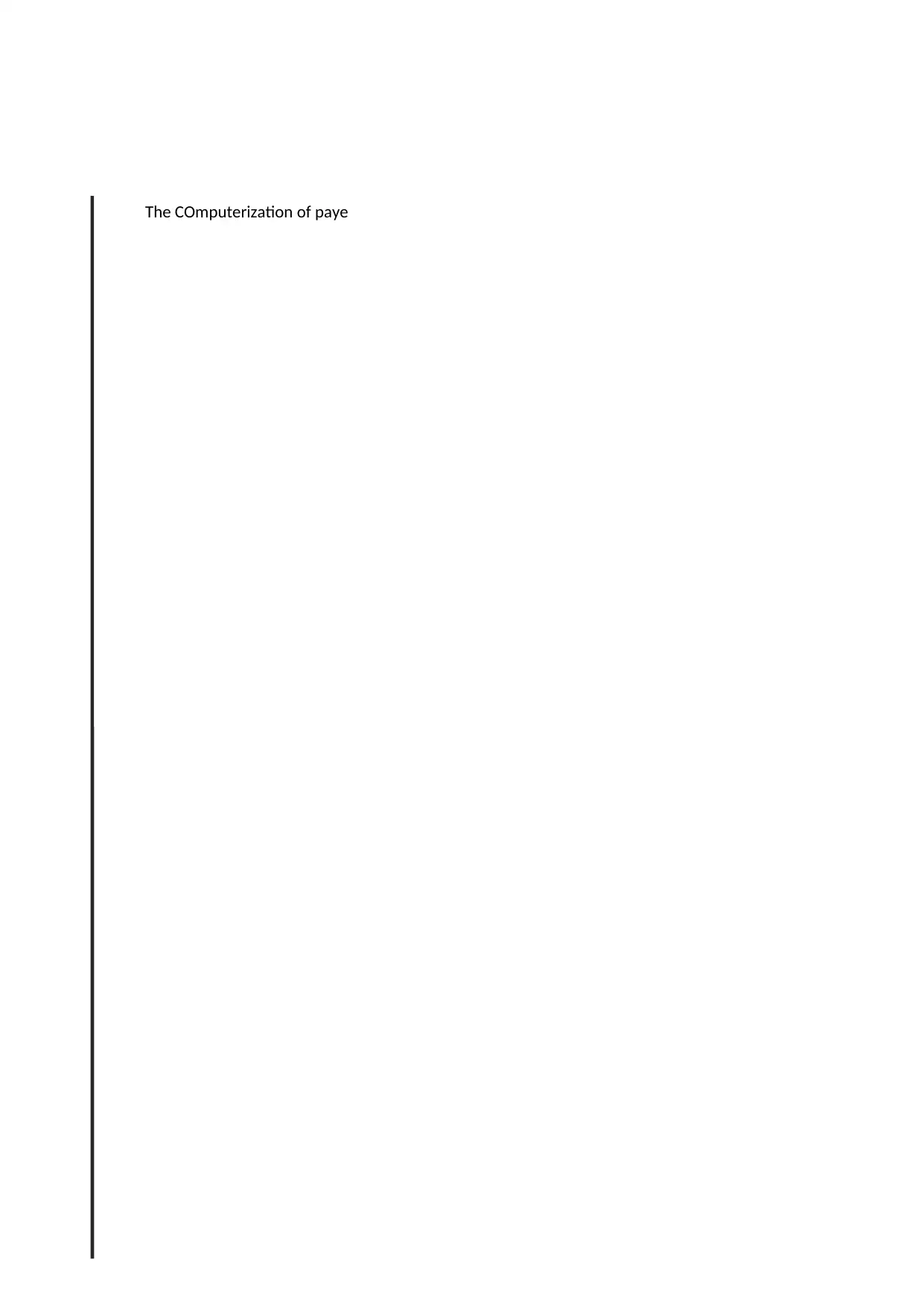
The COmputerization of paye
Paraphrase This Document
Need a fresh take? Get an instant paraphrase of this document with our AI Paraphraser
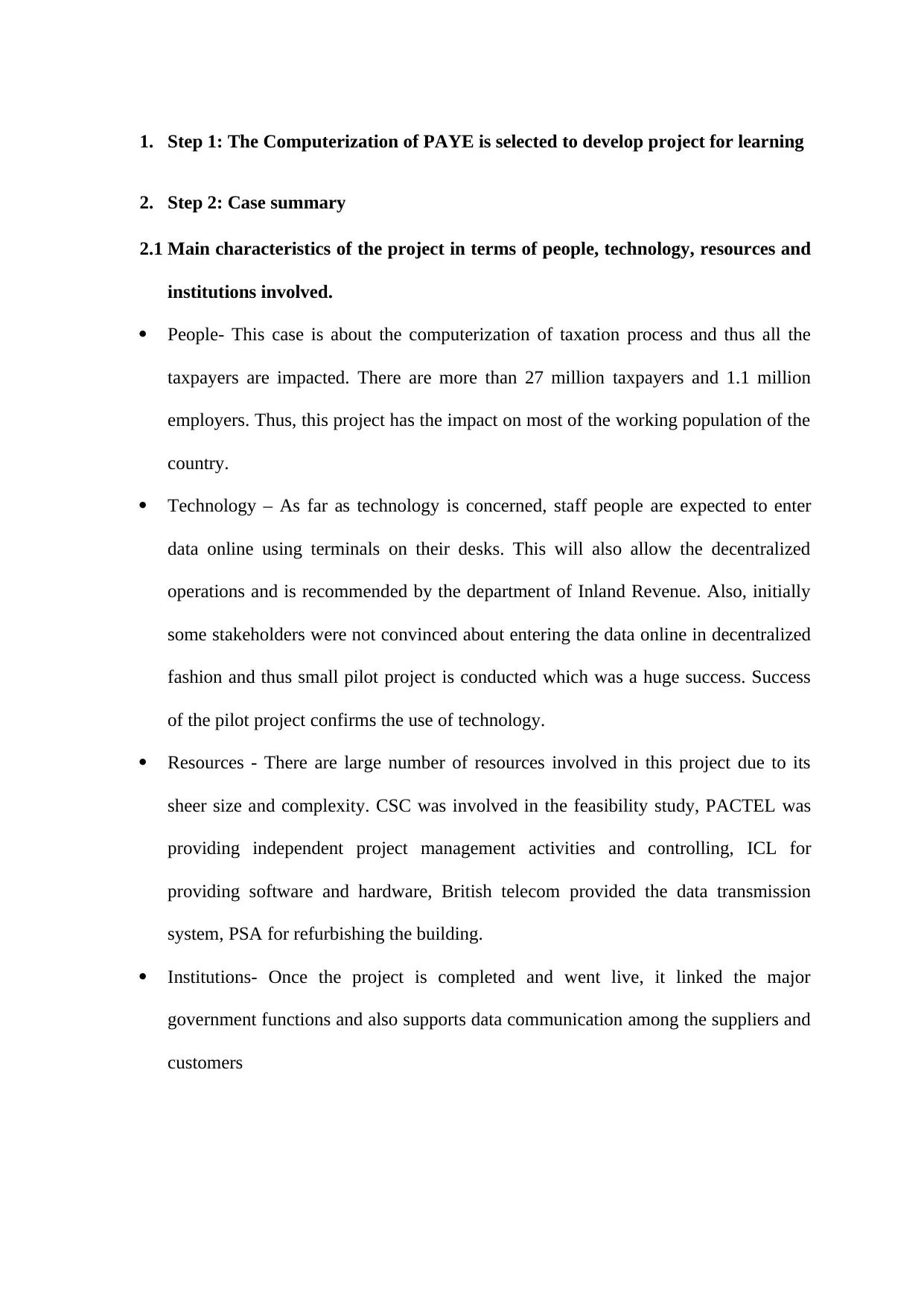
1. Step 1: The Computerization of PAYE is selected to develop project for learning
2. Step 2: Case summary
2.1 Main characteristics of the project in terms of people, technology, resources and
institutions involved.
People- This case is about the computerization of taxation process and thus all the
taxpayers are impacted. There are more than 27 million taxpayers and 1.1 million
employers. Thus, this project has the impact on most of the working population of the
country.
Technology – As far as technology is concerned, staff people are expected to enter
data online using terminals on their desks. This will also allow the decentralized
operations and is recommended by the department of Inland Revenue. Also, initially
some stakeholders were not convinced about entering the data online in decentralized
fashion and thus small pilot project is conducted which was a huge success. Success
of the pilot project confirms the use of technology.
Resources - There are large number of resources involved in this project due to its
sheer size and complexity. CSC was involved in the feasibility study, PACTEL was
providing independent project management activities and controlling, ICL for
providing software and hardware, British telecom provided the data transmission
system, PSA for refurbishing the building.
Institutions- Once the project is completed and went live, it linked the major
government functions and also supports data communication among the suppliers and
customers
2. Step 2: Case summary
2.1 Main characteristics of the project in terms of people, technology, resources and
institutions involved.
People- This case is about the computerization of taxation process and thus all the
taxpayers are impacted. There are more than 27 million taxpayers and 1.1 million
employers. Thus, this project has the impact on most of the working population of the
country.
Technology – As far as technology is concerned, staff people are expected to enter
data online using terminals on their desks. This will also allow the decentralized
operations and is recommended by the department of Inland Revenue. Also, initially
some stakeholders were not convinced about entering the data online in decentralized
fashion and thus small pilot project is conducted which was a huge success. Success
of the pilot project confirms the use of technology.
Resources - There are large number of resources involved in this project due to its
sheer size and complexity. CSC was involved in the feasibility study, PACTEL was
providing independent project management activities and controlling, ICL for
providing software and hardware, British telecom provided the data transmission
system, PSA for refurbishing the building.
Institutions- Once the project is completed and went live, it linked the major
government functions and also supports data communication among the suppliers and
customers
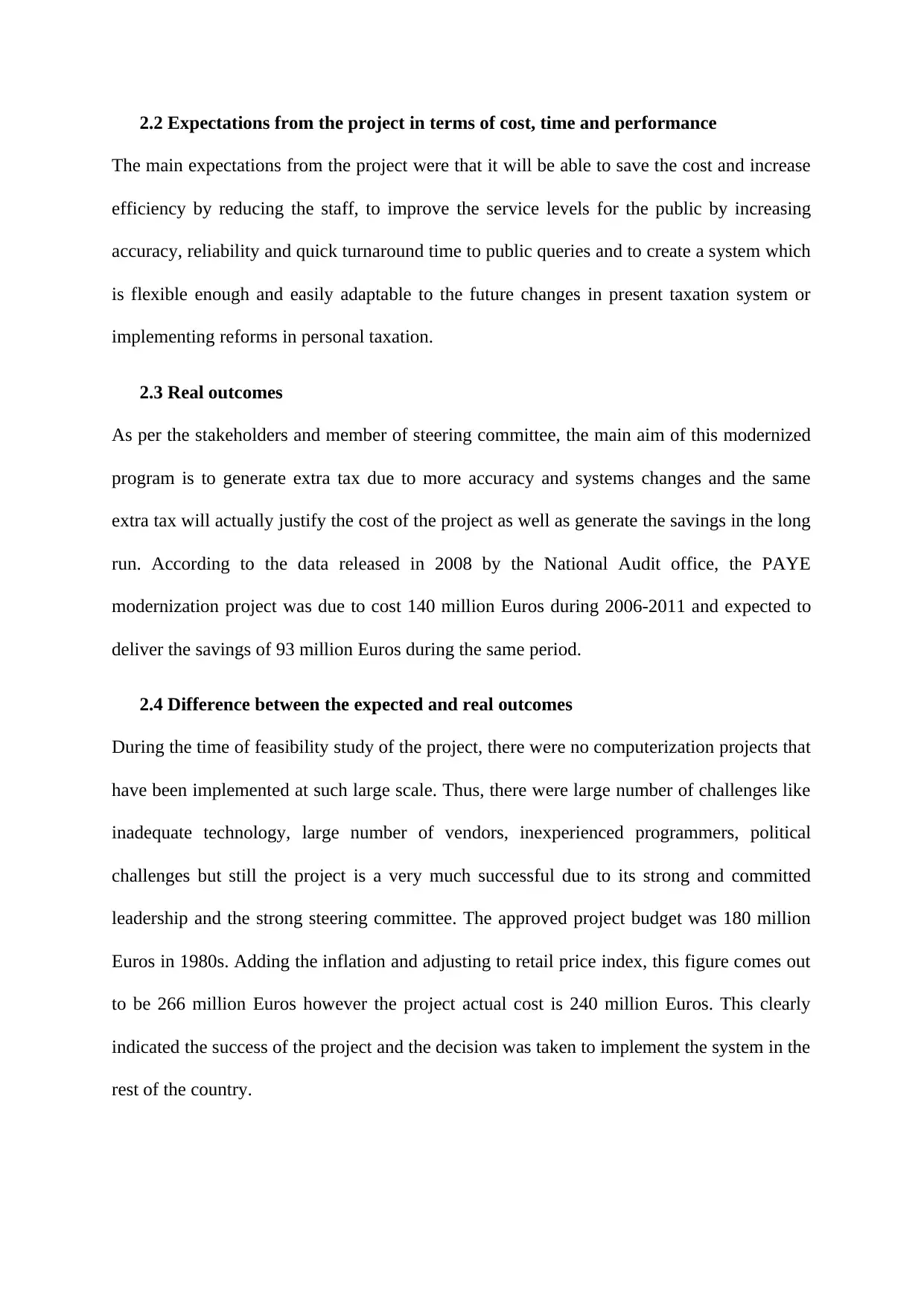
2.2 Expectations from the project in terms of cost, time and performance
The main expectations from the project were that it will be able to save the cost and increase
efficiency by reducing the staff, to improve the service levels for the public by increasing
accuracy, reliability and quick turnaround time to public queries and to create a system which
is flexible enough and easily adaptable to the future changes in present taxation system or
implementing reforms in personal taxation.
2.3 Real outcomes
As per the stakeholders and member of steering committee, the main aim of this modernized
program is to generate extra tax due to more accuracy and systems changes and the same
extra tax will actually justify the cost of the project as well as generate the savings in the long
run. According to the data released in 2008 by the National Audit office, the PAYE
modernization project was due to cost 140 million Euros during 2006-2011 and expected to
deliver the savings of 93 million Euros during the same period.
2.4 Difference between the expected and real outcomes
During the time of feasibility study of the project, there were no computerization projects that
have been implemented at such large scale. Thus, there were large number of challenges like
inadequate technology, large number of vendors, inexperienced programmers, political
challenges but still the project is a very much successful due to its strong and committed
leadership and the strong steering committee. The approved project budget was 180 million
Euros in 1980s. Adding the inflation and adjusting to retail price index, this figure comes out
to be 266 million Euros however the project actual cost is 240 million Euros. This clearly
indicated the success of the project and the decision was taken to implement the system in the
rest of the country.
The main expectations from the project were that it will be able to save the cost and increase
efficiency by reducing the staff, to improve the service levels for the public by increasing
accuracy, reliability and quick turnaround time to public queries and to create a system which
is flexible enough and easily adaptable to the future changes in present taxation system or
implementing reforms in personal taxation.
2.3 Real outcomes
As per the stakeholders and member of steering committee, the main aim of this modernized
program is to generate extra tax due to more accuracy and systems changes and the same
extra tax will actually justify the cost of the project as well as generate the savings in the long
run. According to the data released in 2008 by the National Audit office, the PAYE
modernization project was due to cost 140 million Euros during 2006-2011 and expected to
deliver the savings of 93 million Euros during the same period.
2.4 Difference between the expected and real outcomes
During the time of feasibility study of the project, there were no computerization projects that
have been implemented at such large scale. Thus, there were large number of challenges like
inadequate technology, large number of vendors, inexperienced programmers, political
challenges but still the project is a very much successful due to its strong and committed
leadership and the strong steering committee. The approved project budget was 180 million
Euros in 1980s. Adding the inflation and adjusting to retail price index, this figure comes out
to be 266 million Euros however the project actual cost is 240 million Euros. This clearly
indicated the success of the project and the decision was taken to implement the system in the
rest of the country.
⊘ This is a preview!⊘
Do you want full access?
Subscribe today to unlock all pages.

Trusted by 1+ million students worldwide
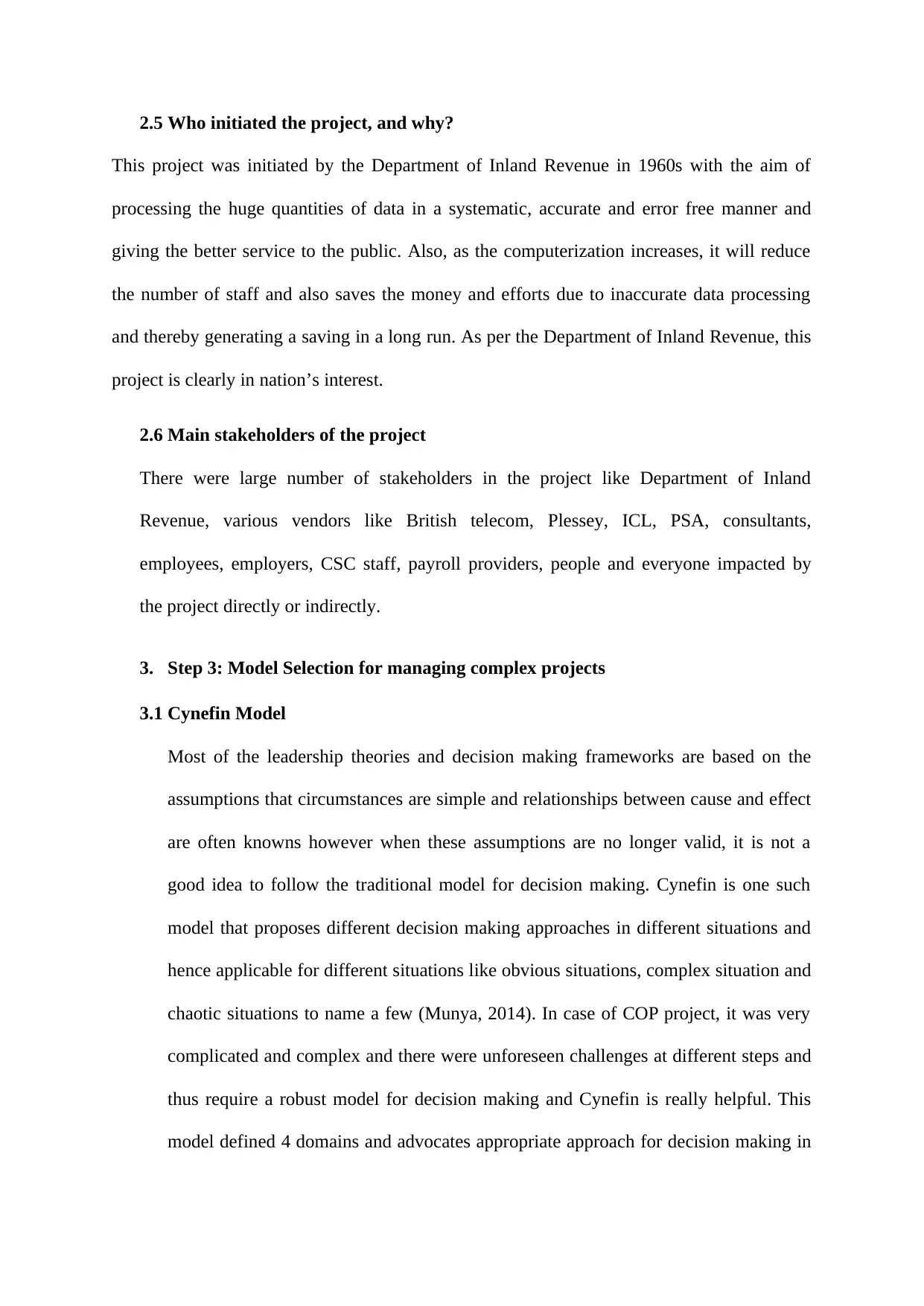
2.5 Who initiated the project, and why?
This project was initiated by the Department of Inland Revenue in 1960s with the aim of
processing the huge quantities of data in a systematic, accurate and error free manner and
giving the better service to the public. Also, as the computerization increases, it will reduce
the number of staff and also saves the money and efforts due to inaccurate data processing
and thereby generating a saving in a long run. As per the Department of Inland Revenue, this
project is clearly in nation’s interest.
2.6 Main stakeholders of the project
There were large number of stakeholders in the project like Department of Inland
Revenue, various vendors like British telecom, Plessey, ICL, PSA, consultants,
employees, employers, CSC staff, payroll providers, people and everyone impacted by
the project directly or indirectly.
3. Step 3: Model Selection for managing complex projects
3.1 Cynefin Model
Most of the leadership theories and decision making frameworks are based on the
assumptions that circumstances are simple and relationships between cause and effect
are often knowns however when these assumptions are no longer valid, it is not a
good idea to follow the traditional model for decision making. Cynefin is one such
model that proposes different decision making approaches in different situations and
hence applicable for different situations like obvious situations, complex situation and
chaotic situations to name a few (Munya, 2014). In case of COP project, it was very
complicated and complex and there were unforeseen challenges at different steps and
thus require a robust model for decision making and Cynefin is really helpful. This
model defined 4 domains and advocates appropriate approach for decision making in
This project was initiated by the Department of Inland Revenue in 1960s with the aim of
processing the huge quantities of data in a systematic, accurate and error free manner and
giving the better service to the public. Also, as the computerization increases, it will reduce
the number of staff and also saves the money and efforts due to inaccurate data processing
and thereby generating a saving in a long run. As per the Department of Inland Revenue, this
project is clearly in nation’s interest.
2.6 Main stakeholders of the project
There were large number of stakeholders in the project like Department of Inland
Revenue, various vendors like British telecom, Plessey, ICL, PSA, consultants,
employees, employers, CSC staff, payroll providers, people and everyone impacted by
the project directly or indirectly.
3. Step 3: Model Selection for managing complex projects
3.1 Cynefin Model
Most of the leadership theories and decision making frameworks are based on the
assumptions that circumstances are simple and relationships between cause and effect
are often knowns however when these assumptions are no longer valid, it is not a
good idea to follow the traditional model for decision making. Cynefin is one such
model that proposes different decision making approaches in different situations and
hence applicable for different situations like obvious situations, complex situation and
chaotic situations to name a few (Munya, 2014). In case of COP project, it was very
complicated and complex and there were unforeseen challenges at different steps and
thus require a robust model for decision making and Cynefin is really helpful. This
model defined 4 domains and advocates appropriate approach for decision making in
Paraphrase This Document
Need a fresh take? Get an instant paraphrase of this document with our AI Paraphraser
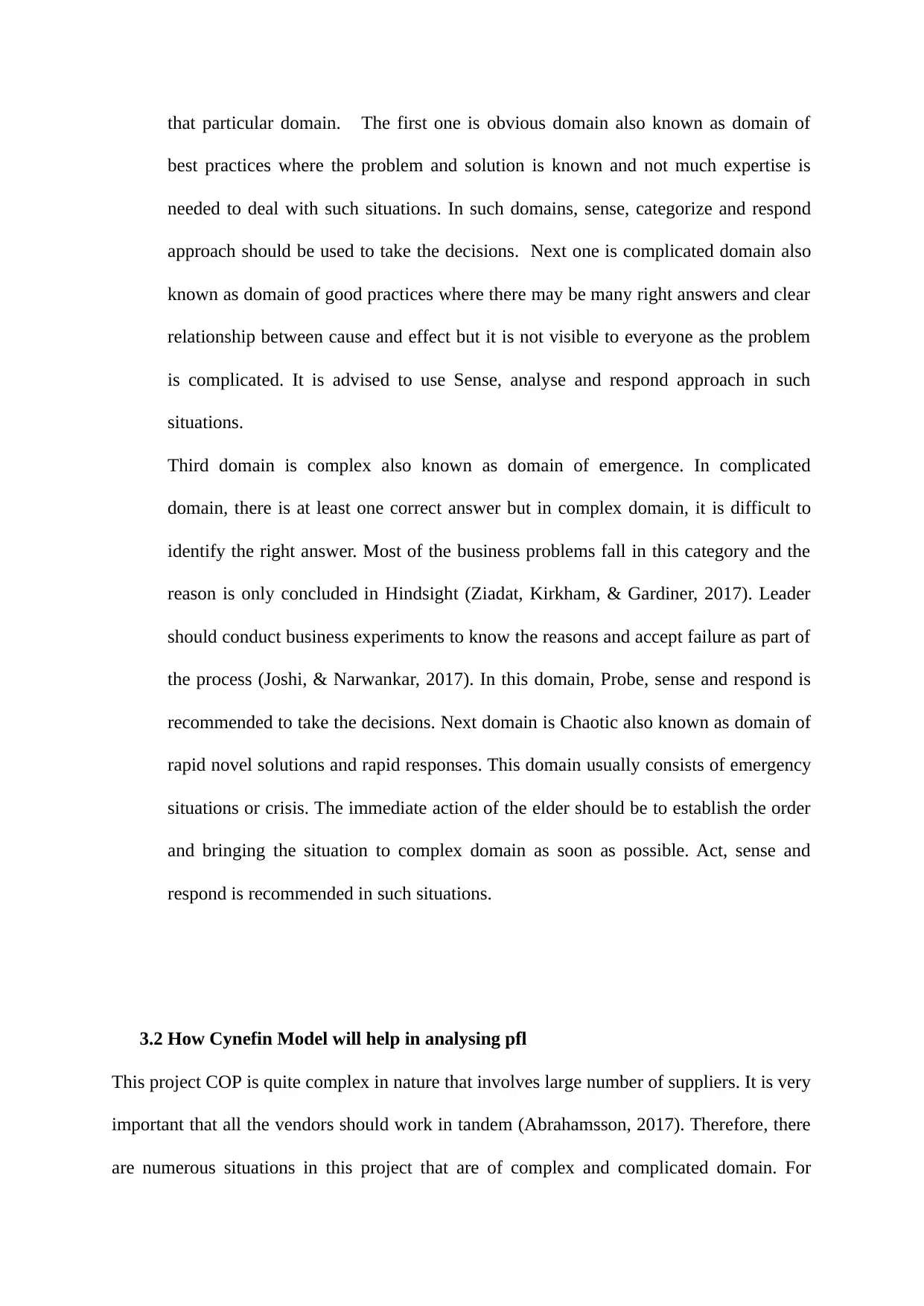
that particular domain. The first one is obvious domain also known as domain of
best practices where the problem and solution is known and not much expertise is
needed to deal with such situations. In such domains, sense, categorize and respond
approach should be used to take the decisions. Next one is complicated domain also
known as domain of good practices where there may be many right answers and clear
relationship between cause and effect but it is not visible to everyone as the problem
is complicated. It is advised to use Sense, analyse and respond approach in such
situations.
Third domain is complex also known as domain of emergence. In complicated
domain, there is at least one correct answer but in complex domain, it is difficult to
identify the right answer. Most of the business problems fall in this category and the
reason is only concluded in Hindsight (Ziadat, Kirkham, & Gardiner, 2017). Leader
should conduct business experiments to know the reasons and accept failure as part of
the process (Joshi, & Narwankar, 2017). In this domain, Probe, sense and respond is
recommended to take the decisions. Next domain is Chaotic also known as domain of
rapid novel solutions and rapid responses. This domain usually consists of emergency
situations or crisis. The immediate action of the elder should be to establish the order
and bringing the situation to complex domain as soon as possible. Act, sense and
respond is recommended in such situations.
3.2 How Cynefin Model will help in analysing pfl
This project COP is quite complex in nature that involves large number of suppliers. It is very
important that all the vendors should work in tandem (Abrahamsson, 2017). Therefore, there
are numerous situations in this project that are of complex and complicated domain. For
best practices where the problem and solution is known and not much expertise is
needed to deal with such situations. In such domains, sense, categorize and respond
approach should be used to take the decisions. Next one is complicated domain also
known as domain of good practices where there may be many right answers and clear
relationship between cause and effect but it is not visible to everyone as the problem
is complicated. It is advised to use Sense, analyse and respond approach in such
situations.
Third domain is complex also known as domain of emergence. In complicated
domain, there is at least one correct answer but in complex domain, it is difficult to
identify the right answer. Most of the business problems fall in this category and the
reason is only concluded in Hindsight (Ziadat, Kirkham, & Gardiner, 2017). Leader
should conduct business experiments to know the reasons and accept failure as part of
the process (Joshi, & Narwankar, 2017). In this domain, Probe, sense and respond is
recommended to take the decisions. Next domain is Chaotic also known as domain of
rapid novel solutions and rapid responses. This domain usually consists of emergency
situations or crisis. The immediate action of the elder should be to establish the order
and bringing the situation to complex domain as soon as possible. Act, sense and
respond is recommended in such situations.
3.2 How Cynefin Model will help in analysing pfl
This project COP is quite complex in nature that involves large number of suppliers. It is very
important that all the vendors should work in tandem (Abrahamsson, 2017). Therefore, there
are numerous situations in this project that are of complex and complicated domain. For
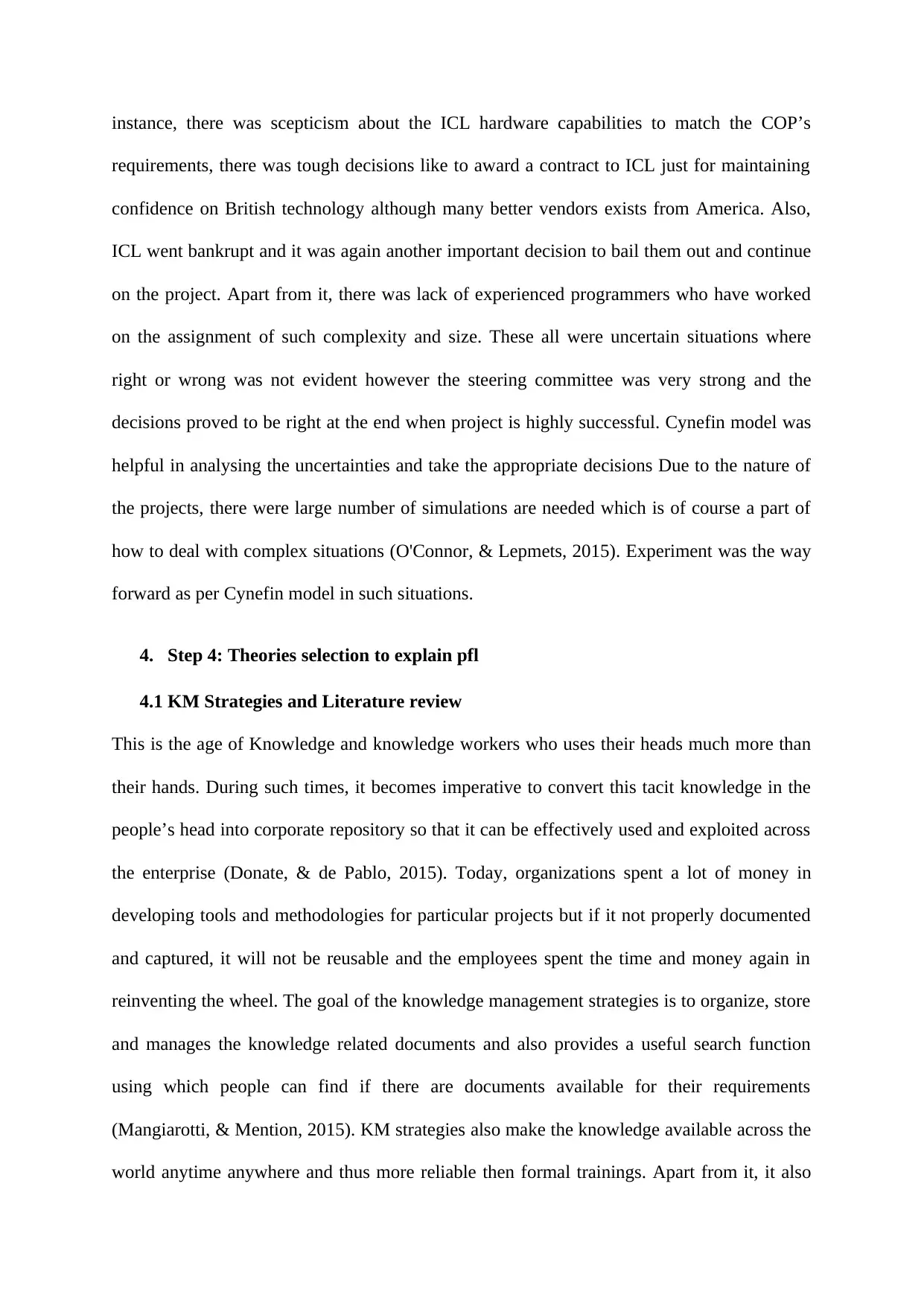
instance, there was scepticism about the ICL hardware capabilities to match the COP’s
requirements, there was tough decisions like to award a contract to ICL just for maintaining
confidence on British technology although many better vendors exists from America. Also,
ICL went bankrupt and it was again another important decision to bail them out and continue
on the project. Apart from it, there was lack of experienced programmers who have worked
on the assignment of such complexity and size. These all were uncertain situations where
right or wrong was not evident however the steering committee was very strong and the
decisions proved to be right at the end when project is highly successful. Cynefin model was
helpful in analysing the uncertainties and take the appropriate decisions Due to the nature of
the projects, there were large number of simulations are needed which is of course a part of
how to deal with complex situations (O'Connor, & Lepmets, 2015). Experiment was the way
forward as per Cynefin model in such situations.
4. Step 4: Theories selection to explain pfl
4.1 KM Strategies and Literature review
This is the age of Knowledge and knowledge workers who uses their heads much more than
their hands. During such times, it becomes imperative to convert this tacit knowledge in the
people’s head into corporate repository so that it can be effectively used and exploited across
the enterprise (Donate, & de Pablo, 2015). Today, organizations spent a lot of money in
developing tools and methodologies for particular projects but if it not properly documented
and captured, it will not be reusable and the employees spent the time and money again in
reinventing the wheel. The goal of the knowledge management strategies is to organize, store
and manages the knowledge related documents and also provides a useful search function
using which people can find if there are documents available for their requirements
(Mangiarotti, & Mention, 2015). KM strategies also make the knowledge available across the
world anytime anywhere and thus more reliable then formal trainings. Apart from it, it also
requirements, there was tough decisions like to award a contract to ICL just for maintaining
confidence on British technology although many better vendors exists from America. Also,
ICL went bankrupt and it was again another important decision to bail them out and continue
on the project. Apart from it, there was lack of experienced programmers who have worked
on the assignment of such complexity and size. These all were uncertain situations where
right or wrong was not evident however the steering committee was very strong and the
decisions proved to be right at the end when project is highly successful. Cynefin model was
helpful in analysing the uncertainties and take the appropriate decisions Due to the nature of
the projects, there were large number of simulations are needed which is of course a part of
how to deal with complex situations (O'Connor, & Lepmets, 2015). Experiment was the way
forward as per Cynefin model in such situations.
4. Step 4: Theories selection to explain pfl
4.1 KM Strategies and Literature review
This is the age of Knowledge and knowledge workers who uses their heads much more than
their hands. During such times, it becomes imperative to convert this tacit knowledge in the
people’s head into corporate repository so that it can be effectively used and exploited across
the enterprise (Donate, & de Pablo, 2015). Today, organizations spent a lot of money in
developing tools and methodologies for particular projects but if it not properly documented
and captured, it will not be reusable and the employees spent the time and money again in
reinventing the wheel. The goal of the knowledge management strategies is to organize, store
and manages the knowledge related documents and also provides a useful search function
using which people can find if there are documents available for their requirements
(Mangiarotti, & Mention, 2015). KM strategies also make the knowledge available across the
world anytime anywhere and thus more reliable then formal trainings. Apart from it, it also
⊘ This is a preview!⊘
Do you want full access?
Subscribe today to unlock all pages.

Trusted by 1+ million students worldwide
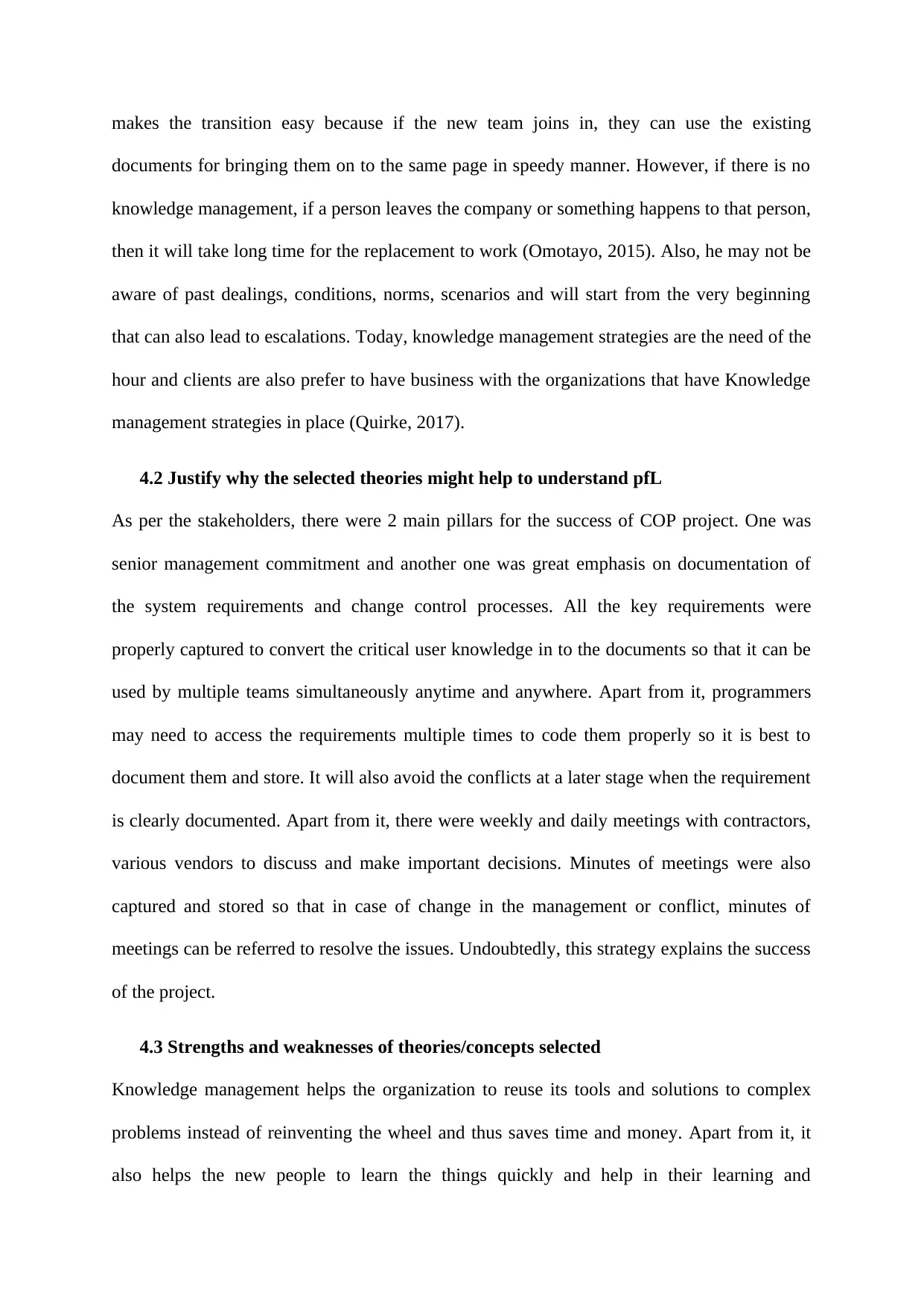
makes the transition easy because if the new team joins in, they can use the existing
documents for bringing them on to the same page in speedy manner. However, if there is no
knowledge management, if a person leaves the company or something happens to that person,
then it will take long time for the replacement to work (Omotayo, 2015). Also, he may not be
aware of past dealings, conditions, norms, scenarios and will start from the very beginning
that can also lead to escalations. Today, knowledge management strategies are the need of the
hour and clients are also prefer to have business with the organizations that have Knowledge
management strategies in place (Quirke, 2017).
4.2 Justify why the selected theories might help to understand pfL
As per the stakeholders, there were 2 main pillars for the success of COP project. One was
senior management commitment and another one was great emphasis on documentation of
the system requirements and change control processes. All the key requirements were
properly captured to convert the critical user knowledge in to the documents so that it can be
used by multiple teams simultaneously anytime and anywhere. Apart from it, programmers
may need to access the requirements multiple times to code them properly so it is best to
document them and store. It will also avoid the conflicts at a later stage when the requirement
is clearly documented. Apart from it, there were weekly and daily meetings with contractors,
various vendors to discuss and make important decisions. Minutes of meetings were also
captured and stored so that in case of change in the management or conflict, minutes of
meetings can be referred to resolve the issues. Undoubtedly, this strategy explains the success
of the project.
4.3 Strengths and weaknesses of theories/concepts selected
Knowledge management helps the organization to reuse its tools and solutions to complex
problems instead of reinventing the wheel and thus saves time and money. Apart from it, it
also helps the new people to learn the things quickly and help in their learning and
documents for bringing them on to the same page in speedy manner. However, if there is no
knowledge management, if a person leaves the company or something happens to that person,
then it will take long time for the replacement to work (Omotayo, 2015). Also, he may not be
aware of past dealings, conditions, norms, scenarios and will start from the very beginning
that can also lead to escalations. Today, knowledge management strategies are the need of the
hour and clients are also prefer to have business with the organizations that have Knowledge
management strategies in place (Quirke, 2017).
4.2 Justify why the selected theories might help to understand pfL
As per the stakeholders, there were 2 main pillars for the success of COP project. One was
senior management commitment and another one was great emphasis on documentation of
the system requirements and change control processes. All the key requirements were
properly captured to convert the critical user knowledge in to the documents so that it can be
used by multiple teams simultaneously anytime and anywhere. Apart from it, programmers
may need to access the requirements multiple times to code them properly so it is best to
document them and store. It will also avoid the conflicts at a later stage when the requirement
is clearly documented. Apart from it, there were weekly and daily meetings with contractors,
various vendors to discuss and make important decisions. Minutes of meetings were also
captured and stored so that in case of change in the management or conflict, minutes of
meetings can be referred to resolve the issues. Undoubtedly, this strategy explains the success
of the project.
4.3 Strengths and weaknesses of theories/concepts selected
Knowledge management helps the organization to reuse its tools and solutions to complex
problems instead of reinventing the wheel and thus saves time and money. Apart from it, it
also helps the new people to learn the things quickly and help in their learning and
Paraphrase This Document
Need a fresh take? Get an instant paraphrase of this document with our AI Paraphraser
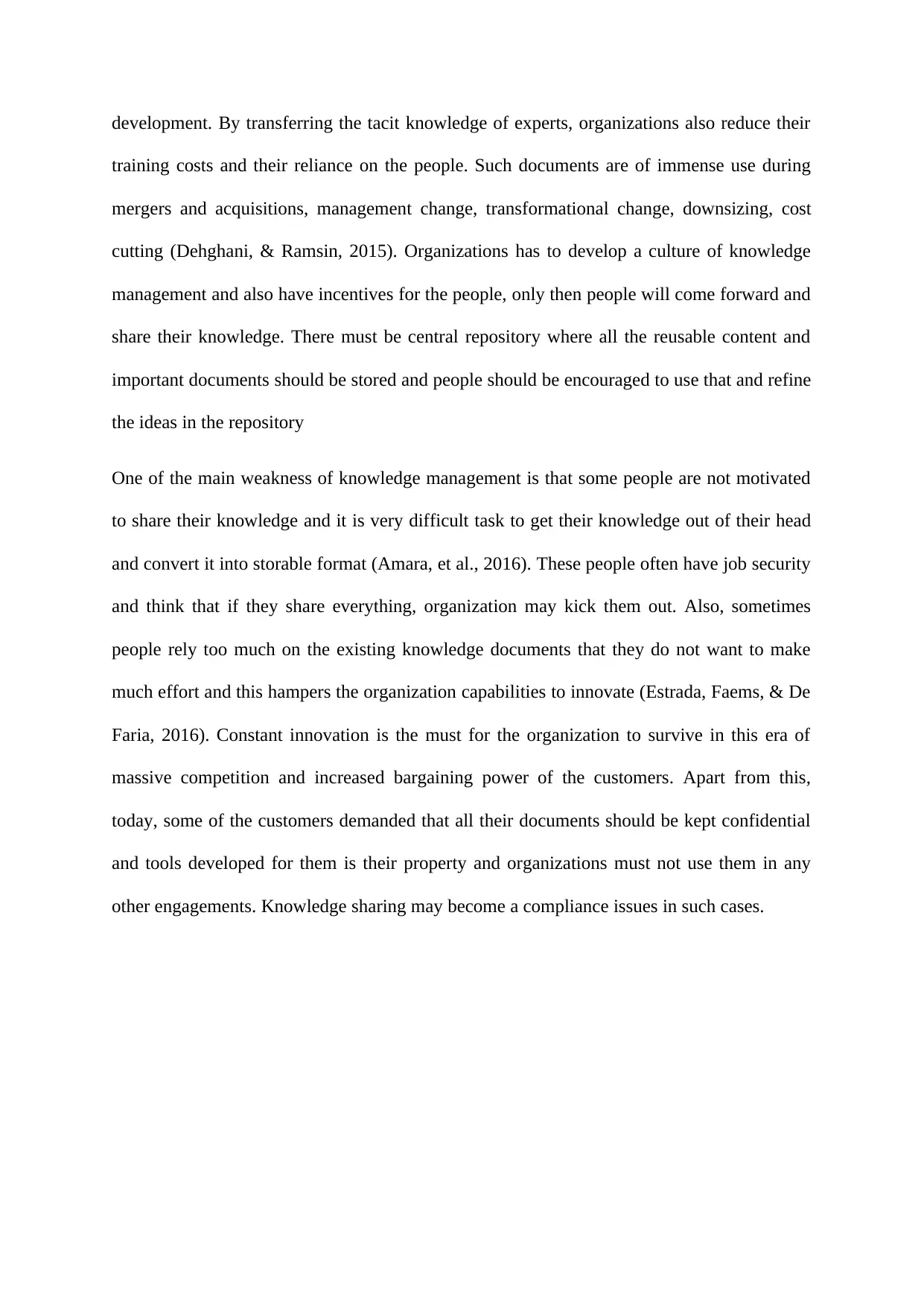
development. By transferring the tacit knowledge of experts, organizations also reduce their
training costs and their reliance on the people. Such documents are of immense use during
mergers and acquisitions, management change, transformational change, downsizing, cost
cutting (Dehghani, & Ramsin, 2015). Organizations has to develop a culture of knowledge
management and also have incentives for the people, only then people will come forward and
share their knowledge. There must be central repository where all the reusable content and
important documents should be stored and people should be encouraged to use that and refine
the ideas in the repository
One of the main weakness of knowledge management is that some people are not motivated
to share their knowledge and it is very difficult task to get their knowledge out of their head
and convert it into storable format (Amara, et al., 2016). These people often have job security
and think that if they share everything, organization may kick them out. Also, sometimes
people rely too much on the existing knowledge documents that they do not want to make
much effort and this hampers the organization capabilities to innovate (Estrada, Faems, & De
Faria, 2016). Constant innovation is the must for the organization to survive in this era of
massive competition and increased bargaining power of the customers. Apart from this,
today, some of the customers demanded that all their documents should be kept confidential
and tools developed for them is their property and organizations must not use them in any
other engagements. Knowledge sharing may become a compliance issues in such cases.
training costs and their reliance on the people. Such documents are of immense use during
mergers and acquisitions, management change, transformational change, downsizing, cost
cutting (Dehghani, & Ramsin, 2015). Organizations has to develop a culture of knowledge
management and also have incentives for the people, only then people will come forward and
share their knowledge. There must be central repository where all the reusable content and
important documents should be stored and people should be encouraged to use that and refine
the ideas in the repository
One of the main weakness of knowledge management is that some people are not motivated
to share their knowledge and it is very difficult task to get their knowledge out of their head
and convert it into storable format (Amara, et al., 2016). These people often have job security
and think that if they share everything, organization may kick them out. Also, sometimes
people rely too much on the existing knowledge documents that they do not want to make
much effort and this hampers the organization capabilities to innovate (Estrada, Faems, & De
Faria, 2016). Constant innovation is the must for the organization to survive in this era of
massive competition and increased bargaining power of the customers. Apart from this,
today, some of the customers demanded that all their documents should be kept confidential
and tools developed for them is their property and organizations must not use them in any
other engagements. Knowledge sharing may become a compliance issues in such cases.

⊘ This is a preview!⊘
Do you want full access?
Subscribe today to unlock all pages.

Trusted by 1+ million students worldwide
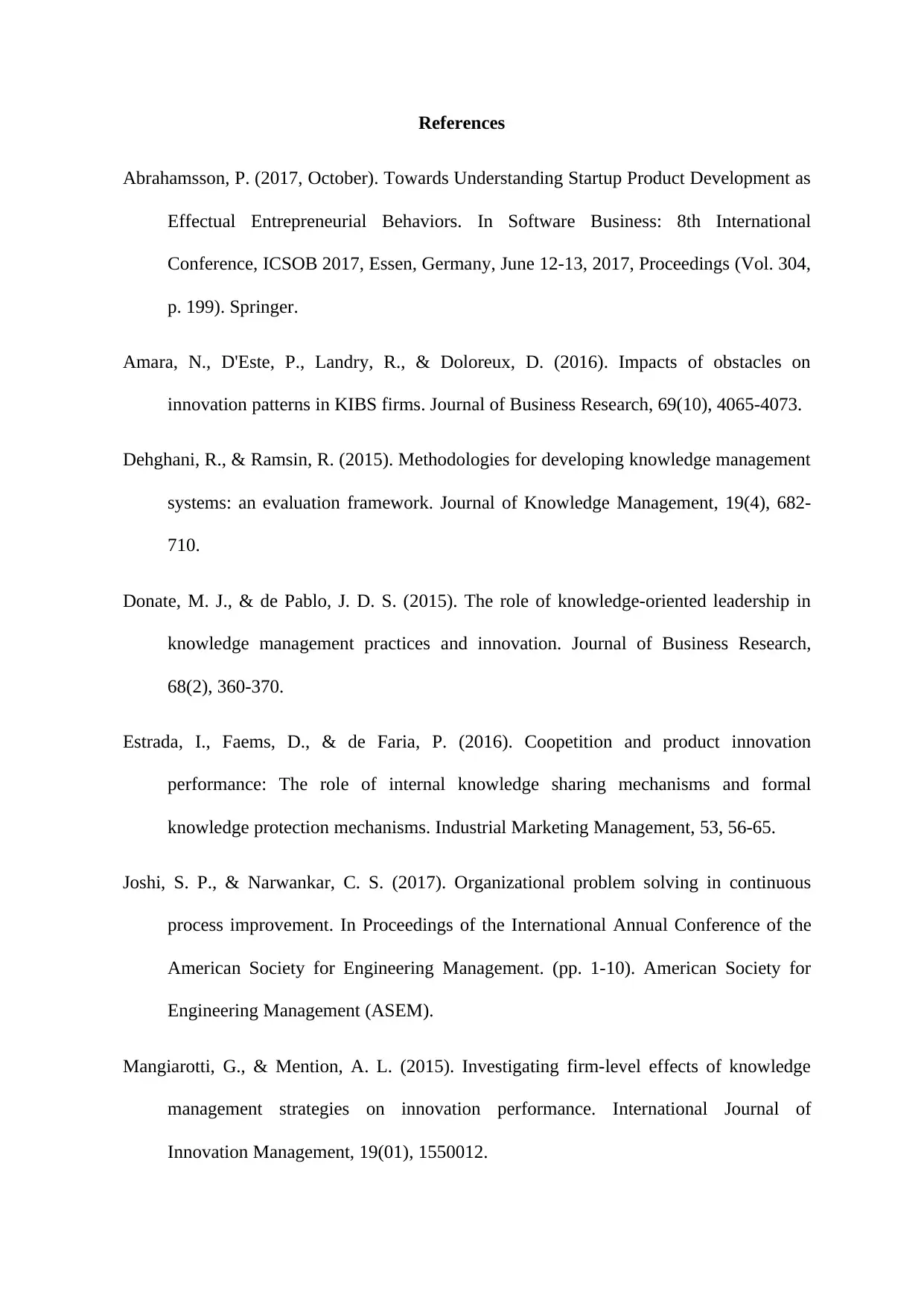
References
Abrahamsson, P. (2017, October). Towards Understanding Startup Product Development as
Effectual Entrepreneurial Behaviors. In Software Business: 8th International
Conference, ICSOB 2017, Essen, Germany, June 12-13, 2017, Proceedings (Vol. 304,
p. 199). Springer.
Amara, N., D'Este, P., Landry, R., & Doloreux, D. (2016). Impacts of obstacles on
innovation patterns in KIBS firms. Journal of Business Research, 69(10), 4065-4073.
Dehghani, R., & Ramsin, R. (2015). Methodologies for developing knowledge management
systems: an evaluation framework. Journal of Knowledge Management, 19(4), 682-
710.
Donate, M. J., & de Pablo, J. D. S. (2015). The role of knowledge-oriented leadership in
knowledge management practices and innovation. Journal of Business Research,
68(2), 360-370.
Estrada, I., Faems, D., & de Faria, P. (2016). Coopetition and product innovation
performance: The role of internal knowledge sharing mechanisms and formal
knowledge protection mechanisms. Industrial Marketing Management, 53, 56-65.
Joshi, S. P., & Narwankar, C. S. (2017). Organizational problem solving in continuous
process improvement. In Proceedings of the International Annual Conference of the
American Society for Engineering Management. (pp. 1-10). American Society for
Engineering Management (ASEM).
Mangiarotti, G., & Mention, A. L. (2015). Investigating firm-level effects of knowledge
management strategies on innovation performance. International Journal of
Innovation Management, 19(01), 1550012.
Abrahamsson, P. (2017, October). Towards Understanding Startup Product Development as
Effectual Entrepreneurial Behaviors. In Software Business: 8th International
Conference, ICSOB 2017, Essen, Germany, June 12-13, 2017, Proceedings (Vol. 304,
p. 199). Springer.
Amara, N., D'Este, P., Landry, R., & Doloreux, D. (2016). Impacts of obstacles on
innovation patterns in KIBS firms. Journal of Business Research, 69(10), 4065-4073.
Dehghani, R., & Ramsin, R. (2015). Methodologies for developing knowledge management
systems: an evaluation framework. Journal of Knowledge Management, 19(4), 682-
710.
Donate, M. J., & de Pablo, J. D. S. (2015). The role of knowledge-oriented leadership in
knowledge management practices and innovation. Journal of Business Research,
68(2), 360-370.
Estrada, I., Faems, D., & de Faria, P. (2016). Coopetition and product innovation
performance: The role of internal knowledge sharing mechanisms and formal
knowledge protection mechanisms. Industrial Marketing Management, 53, 56-65.
Joshi, S. P., & Narwankar, C. S. (2017). Organizational problem solving in continuous
process improvement. In Proceedings of the International Annual Conference of the
American Society for Engineering Management. (pp. 1-10). American Society for
Engineering Management (ASEM).
Mangiarotti, G., & Mention, A. L. (2015). Investigating firm-level effects of knowledge
management strategies on innovation performance. International Journal of
Innovation Management, 19(01), 1550012.
Paraphrase This Document
Need a fresh take? Get an instant paraphrase of this document with our AI Paraphraser
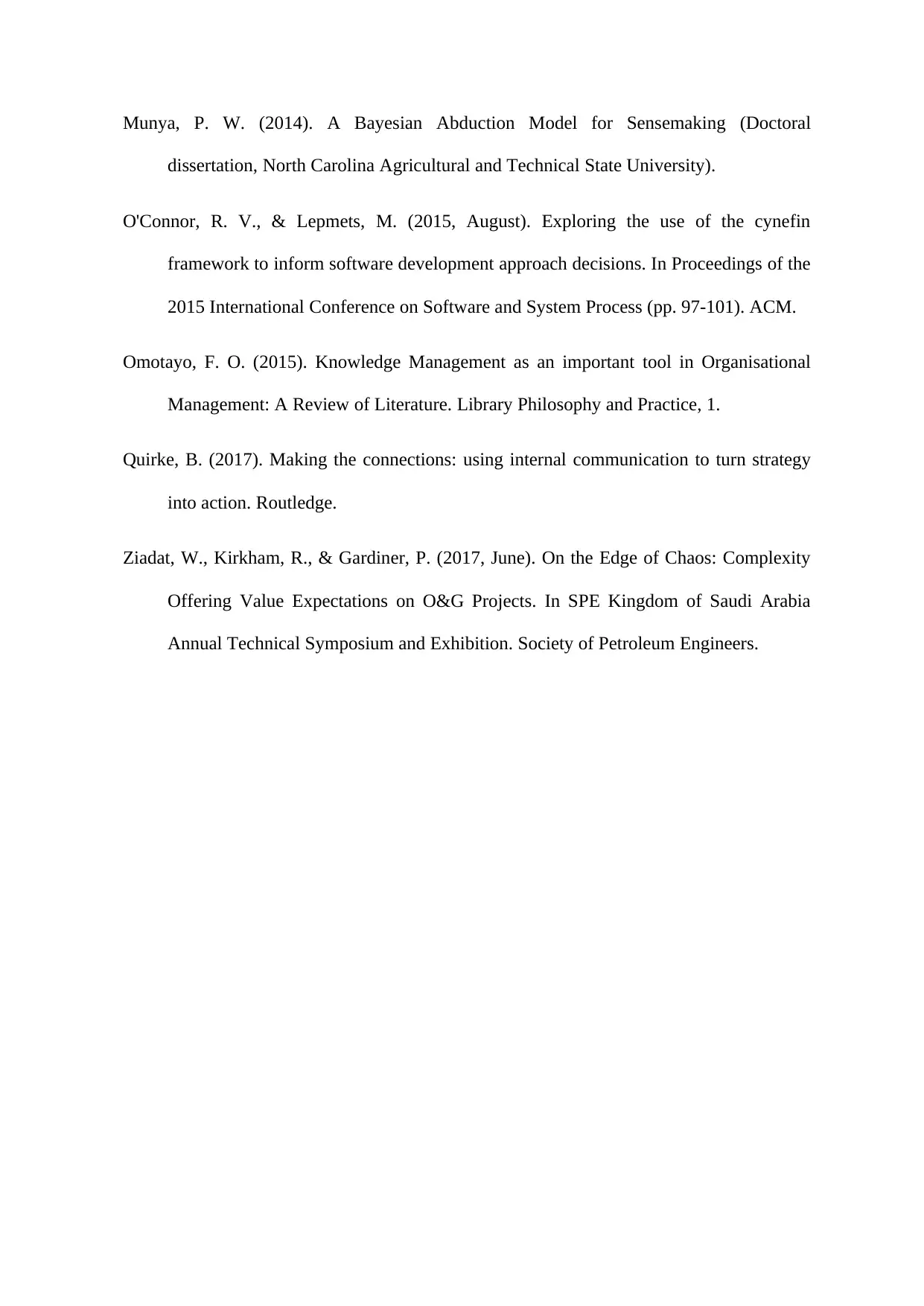
Munya, P. W. (2014). A Bayesian Abduction Model for Sensemaking (Doctoral
dissertation, North Carolina Agricultural and Technical State University).
O'Connor, R. V., & Lepmets, M. (2015, August). Exploring the use of the cynefin
framework to inform software development approach decisions. In Proceedings of the
2015 International Conference on Software and System Process (pp. 97-101). ACM.
Omotayo, F. O. (2015). Knowledge Management as an important tool in Organisational
Management: A Review of Literature. Library Philosophy and Practice, 1.
Quirke, B. (2017). Making the connections: using internal communication to turn strategy
into action. Routledge.
Ziadat, W., Kirkham, R., & Gardiner, P. (2017, June). On the Edge of Chaos: Complexity
Offering Value Expectations on O&G Projects. In SPE Kingdom of Saudi Arabia
Annual Technical Symposium and Exhibition. Society of Petroleum Engineers.
dissertation, North Carolina Agricultural and Technical State University).
O'Connor, R. V., & Lepmets, M. (2015, August). Exploring the use of the cynefin
framework to inform software development approach decisions. In Proceedings of the
2015 International Conference on Software and System Process (pp. 97-101). ACM.
Omotayo, F. O. (2015). Knowledge Management as an important tool in Organisational
Management: A Review of Literature. Library Philosophy and Practice, 1.
Quirke, B. (2017). Making the connections: using internal communication to turn strategy
into action. Routledge.
Ziadat, W., Kirkham, R., & Gardiner, P. (2017, June). On the Edge of Chaos: Complexity
Offering Value Expectations on O&G Projects. In SPE Kingdom of Saudi Arabia
Annual Technical Symposium and Exhibition. Society of Petroleum Engineers.
1 out of 11
Your All-in-One AI-Powered Toolkit for Academic Success.
+13062052269
info@desklib.com
Available 24*7 on WhatsApp / Email
![[object Object]](/_next/static/media/star-bottom.7253800d.svg)
Unlock your academic potential
Copyright © 2020–2025 A2Z Services. All Rights Reserved. Developed and managed by ZUCOL.
